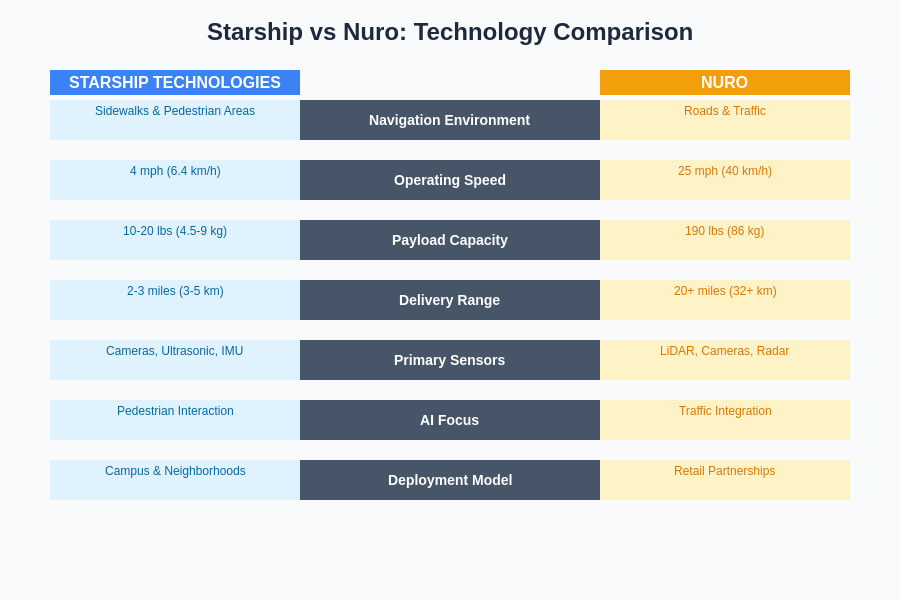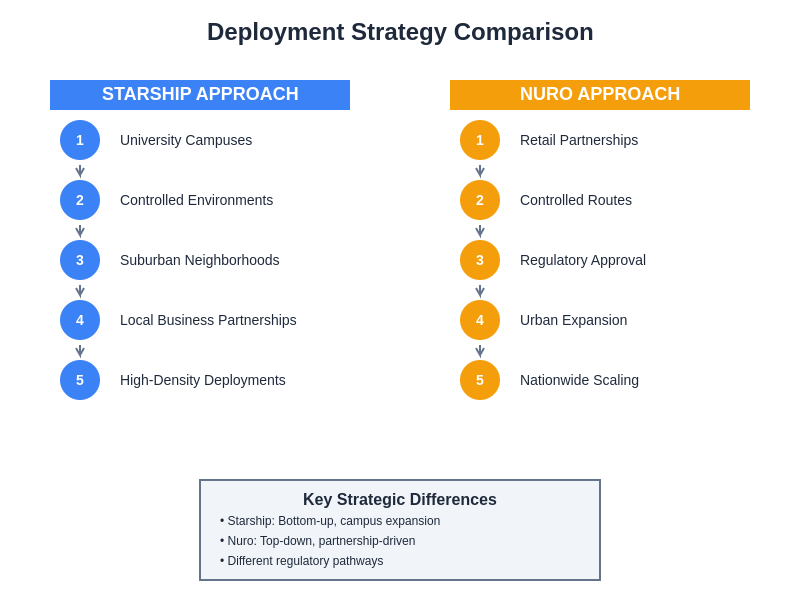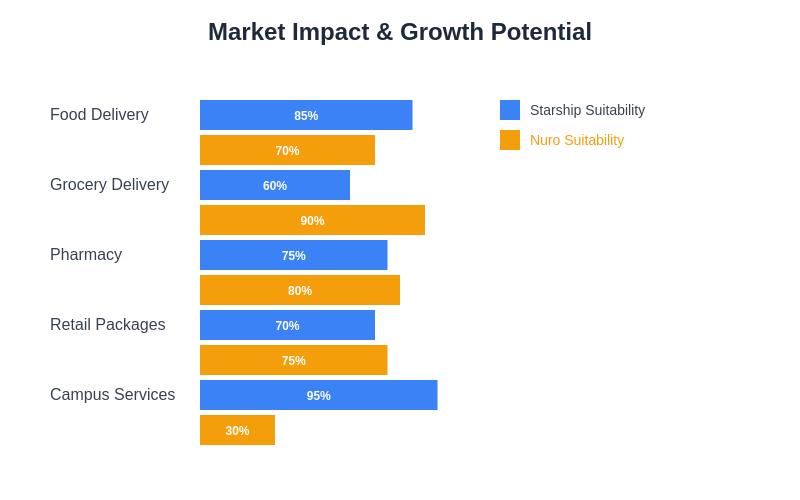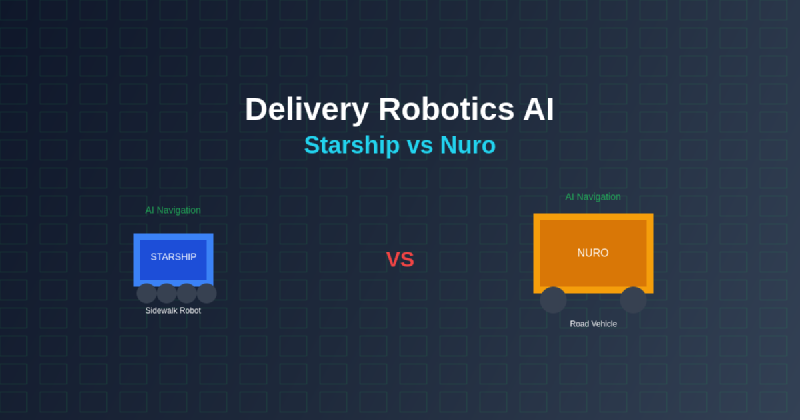The autonomous delivery revolution has fundamentally transformed the landscape of last-mile logistics, with two pioneering companies leading the charge toward a future where robotic systems seamlessly navigate urban environments to deliver goods directly to consumers. Starship Technologies and Nuro represent distinct yet complementary approaches to solving the complex challenges of autonomous delivery, each deploying sophisticated artificial intelligence systems that navigate real-world environments while ensuring safe, efficient, and reliable service delivery.
Explore the latest AI trends in robotics to understand how autonomous delivery systems are reshaping urban logistics and consumer expectations. The emergence of these robotic delivery platforms represents more than technological innovation; it signifies a fundamental shift in how society approaches the movement of goods in densely populated areas, addressing challenges ranging from traffic congestion to environmental sustainability while creating new paradigms for human-robot interaction in public spaces.
The Evolution of Autonomous Delivery Systems
The development of autonomous delivery robotics has emerged from the intersection of multiple technological advances, including computer vision, machine learning, sensor fusion, and real-time decision-making algorithms. Both Starship and Nuro have pioneered unique approaches to these challenges, developing systems that can navigate complex urban environments while maintaining the reliability and safety standards necessary for commercial deployment at scale.
Starship Technologies has focused on developing small, sidewalk-traveling robots that operate in close proximity to pedestrians, requiring sophisticated AI systems capable of understanding and responding to human behavior patterns. These robots must navigate crowded sidewalks, cross streets safely, and interact with various obstacles while maintaining situational awareness that ensures both pedestrian safety and successful delivery completion.
Nuro has taken a fundamentally different approach by developing larger, street-traveling vehicles designed specifically for goods delivery without human passengers. This approach allows for different design considerations and safety protocols while requiring AI systems capable of navigating complex traffic patterns, interacting with human drivers, and operating within existing transportation infrastructure.
Starship Technologies: Sidewalk Navigation Mastery
Starship’s approach to autonomous delivery centers on small, six-wheeled robots that traverse sidewalks and pedestrian areas with remarkable precision and reliability. The company’s AI systems have been specifically designed to understand and navigate the complex dynamics of pedestrian environments, where unpredictable human behavior, varying terrain conditions, and numerous obstacles create challenging navigation scenarios that require sophisticated real-time decision-making capabilities.
The artificial intelligence powering Starship robots incorporates advanced computer vision systems that can identify and classify various objects, people, and obstacles in real-time. These systems utilize multiple cameras, ultrasonic sensors, and IMU technology to create detailed environmental maps while continuously updating their understanding of dynamic conditions such as moving pedestrians, changing weather conditions, and temporary obstacles like construction barriers or parked bicycles.
Experience advanced AI capabilities with Claude for understanding complex autonomous systems and their real-world applications in robotics and navigation. The integration of machine learning algorithms allows Starship robots to continuously improve their navigation capabilities through experience, learning to better predict pedestrian behavior patterns and optimize route planning based on historical data and real-time environmental conditions.
The company’s deployment strategy has focused on controlled environments such as university campuses and suburban neighborhoods, where sidewalk infrastructure is well-maintained and traffic patterns are relatively predictable. This approach has allowed Starship to refine their AI systems through extensive real-world testing while building operational expertise in areas with favorable conditions for autonomous sidewalk navigation.
Starship’s robots demonstrate remarkable adaptability in handling various weather conditions, from rain and snow to varying lighting conditions throughout different times of day. The AI systems incorporate weather-specific navigation algorithms that adjust speed, route selection, and obstacle detection sensitivity based on environmental conditions, ensuring consistent performance across diverse operational scenarios.
Nuro: Revolutionary Road-Based Delivery Vehicles
Nuro’s autonomous delivery vehicles represent a fundamentally different approach to last-mile logistics, utilizing purpose-built vehicles designed exclusively for goods transportation without human passengers. This design philosophy has enabled Nuro to optimize their vehicles and AI systems specifically for delivery tasks, creating solutions that can carry larger payloads over greater distances while operating within existing road infrastructure.
The artificial intelligence systems developed by Nuro incorporate sophisticated sensor fusion technologies that combine data from cameras, LiDAR, radar, and ultrasonic sensors to create comprehensive understanding of complex traffic environments. These systems must process vast amounts of real-time data to make split-second decisions about navigation, obstacle avoidance, and interaction with other vehicles while maintaining the safety standards necessary for operation on public roads.
Nuro’s AI capabilities extend beyond basic navigation to include advanced route optimization algorithms that consider factors such as traffic patterns, delivery time windows, vehicle capacity constraints, and energy efficiency requirements. The system can dynamically adjust delivery routes based on real-time conditions, ensuring optimal efficiency while maintaining delivery commitments to customers and partner retailers.
The company’s partnership strategy with major retailers such as Kroger and Domino’s has provided extensive opportunities for real-world testing and refinement of their AI systems under diverse operational conditions. These partnerships have enabled Nuro to develop specialized algorithms for different types of delivery scenarios, from grocery delivery requiring temperature-controlled storage to restaurant delivery demanding rapid transit times.

The technological approaches employed by Starship and Nuro reflect their distinct operational environments and delivery requirements. While Starship focuses on pedestrian-scale navigation with emphasis on social robotics and human interaction, Nuro prioritizes vehicle-scale autonomous driving with emphasis on traffic integration and cargo optimization.
AI Navigation and Safety Systems
Both companies have invested heavily in developing AI systems capable of ensuring safe operation in complex real-world environments, though their approaches differ significantly based on their respective operational domains. Safety considerations for sidewalk-traveling robots involve different challenges and solutions compared to road-traveling vehicles, requiring specialized AI architectures optimized for each environment.
Starship’s safety systems prioritize pedestrian interaction and sidewalk navigation, incorporating algorithms that can predict and respond to human movement patterns while maintaining safe distances and speeds. The robots are designed to yield right-of-way to pedestrians and can communicate their intentions through visual and audio signals, creating more predictable and comfortable interactions between humans and robotic systems.
The AI systems also incorporate advanced anomaly detection capabilities that can identify unusual or potentially dangerous situations, such as aggressive behavior from pedestrians or unexpected obstacles that might indicate safety hazards. When such situations are detected, the robots can take appropriate protective actions, including stopping, requesting remote human assistance, or selecting alternative routes.
Nuro’s safety systems focus on vehicular traffic integration and collision avoidance, utilizing sophisticated prediction algorithms that can anticipate the behavior of other vehicles, cyclists, and pedestrians in complex traffic scenarios. The company’s AI systems have been designed to operate conservatively, prioritizing safety over speed or efficiency when faced with uncertain or potentially dangerous situations.
Discover comprehensive AI research capabilities with Perplexity for analyzing autonomous vehicle safety standards and regulatory frameworks that govern robotic delivery systems. The development of robust safety protocols requires continuous research and adaptation to evolving regulatory requirements and public safety expectations.
Operational Deployment and Market Penetration
The deployment strategies employed by Starship and Nuro reflect their different technological approaches and target markets, with each company focusing on environments and use cases that best leverage their respective AI capabilities and operational advantages. These strategies have been shaped by regulatory considerations, infrastructure requirements, and market demand patterns that vary significantly across different geographic regions and demographic segments.

The strategic evolution of both companies demonstrates how different technological approaches lead to distinct market entry strategies and operational scaling methodologies. Understanding these deployment patterns provides insights into the broader adoption trajectory of autonomous delivery systems across various market segments.
Starship has achieved significant market penetration in controlled environments such as university campuses, where the combination of high delivery demand, well-maintained sidewalk infrastructure, and tech-savvy user populations creates ideal conditions for robotic delivery services. The company’s AI systems have been refined through millions of autonomous miles traveled in these environments, creating robust operational capabilities that can be extended to similar markets.
The expansion into residential neighborhoods has required additional AI development to handle more complex sidewalk conditions, varying infrastructure quality, and diverse user populations with different comfort levels regarding robotic delivery services. Starship’s systems have demonstrated remarkable adaptability in learning new environments and adjusting their operation parameters based on local conditions and user feedback.
Nuro’s deployment strategy has focused on partnerships with established retailers that can provide consistent delivery volume and well-defined operational parameters. These partnerships have enabled the company to develop specialized AI capabilities for different types of delivery scenarios while building the operational infrastructure necessary for scalable autonomous delivery services.
The regulatory landscape for road-traveling autonomous vehicles has required Nuro to work closely with transportation authorities and safety regulators to establish appropriate operational frameworks. This collaboration has contributed to the development of industry standards and best practices that benefit the broader autonomous vehicle ecosystem while ensuring public safety and acceptance of robotic delivery systems.
Economic Impact and Business Model Innovation
The economic implications of autonomous delivery robotics extend far beyond the immediate operational efficiencies achieved by Starship and Nuro, encompassing broader impacts on employment patterns, urban planning, retail distribution strategies, and consumer behavior patterns. Both companies have demonstrated that AI-powered delivery systems can reduce operational costs while improving service reliability and customer satisfaction.
Starship’s economic model leverages the low operational costs of sidewalk robots to enable profitable delivery of small orders that would otherwise be uneconomical using traditional delivery methods. The AI systems optimize delivery routes and timing to maximize efficiency while minimizing energy consumption and operational overhead, creating sustainable business models that can support widespread deployment.
The company’s focus on partnerships with restaurants, grocery stores, and other local businesses has created new revenue opportunities for these partners while providing consumers with convenient access to goods and services. The AI systems can predict demand patterns and optimize inventory positioning to reduce delivery times and improve customer satisfaction.
Nuro’s economic impact centers on transforming the economics of medium-distance delivery for larger orders, particularly in suburban and urban areas where traditional delivery methods face challenges related to traffic congestion, parking limitations, and driver availability. The company’s AI systems enable efficient utilization of delivery vehicles while reducing labor costs and improving delivery predictability.

The strategic approaches taken by both companies demonstrate how AI-powered delivery systems can create value through different operational models and market positioning strategies. The success of these approaches provides insights into the broader potential for autonomous delivery systems to transform logistics and retail industries.
Technological Challenges and AI Innovations
The development of reliable autonomous delivery systems has required both companies to address numerous technological challenges that extend beyond basic navigation and obstacle avoidance. These challenges include weather adaptation, security and theft prevention, energy management, maintenance scheduling, and continuous system improvement through machine learning and real-world operational data.
Starship’s AI systems have been designed to operate reliably across various weather conditions, incorporating algorithms that can adjust navigation behavior based on factors such as visibility, surface conditions, and temperature variations. The robots can detect and respond to challenging conditions such as ice, snow accumulation, or heavy rain that might affect their mobility or sensor performance.
Security considerations have required the development of sophisticated monitoring and protection systems that can detect and respond to tampering, theft attempts, or vandalism. The AI systems incorporate behavioral analysis capabilities that can identify suspicious activities and take appropriate protective actions while maintaining normal operations for legitimate interactions.
Nuro’s technological challenges include the complexity of integrating autonomous vehicles into existing traffic infrastructure while maintaining the safety and reliability standards necessary for commercial operation. The company’s AI systems must continuously adapt to changing traffic patterns, construction zones, new signage, and other dynamic elements of the road environment.
Energy management represents a critical challenge for both companies, requiring AI systems that can optimize battery usage, plan charging schedules, and predict energy requirements based on route conditions and payload characteristics. These systems must balance operational efficiency with service reliability to ensure consistent delivery performance across all operating conditions.
Consumer Adoption and User Experience Design
The successful deployment of autonomous delivery systems requires more than technological excellence; it demands careful attention to user experience design and consumer adoption strategies that build trust and confidence in robotic delivery services. Both Starship and Nuro have invested significantly in developing AI systems that can provide intuitive, reliable, and pleasant interactions with consumers throughout the delivery process.
Starship’s approach to user experience emphasizes simplicity and reliability, with AI systems designed to provide clear communication about delivery status, arrival times, and any potential issues that might affect service. The robots can interact with customers through mobile applications while providing visual and audio feedback during the delivery process to ensure smooth handoffs and customer satisfaction.
The company’s AI systems incorporate learning algorithms that can adapt to individual customer preferences and delivery patterns, optimizing routes and timing based on historical data and user feedback. This personalization capability helps build customer loyalty while improving operational efficiency through better demand prediction and resource allocation.
Nuro’s user experience design focuses on seamless integration with existing retail and ordering systems, utilizing AI capabilities to coordinate delivery timing with customer schedules and preferences. The company’s systems can provide real-time tracking and communication while handling various delivery scenarios such as contactless delivery, secure storage, and temperature-controlled transportation.
Consumer education and trust-building represent ongoing challenges that both companies address through transparency about their AI systems, safety protocols, and operational procedures. The development of clear communication strategies and reliable performance helps build public acceptance of autonomous delivery technologies while addressing concerns about safety, privacy, and job displacement.
Regulatory Landscape and Compliance Framework
The regulatory environment for autonomous delivery systems continues to evolve as governments and transportation authorities develop frameworks for safe and effective integration of robotic systems into public spaces and transportation networks. Both Starship and Nuro have played active roles in shaping these regulatory discussions while ensuring compliance with existing safety and operational requirements.
Starship’s sidewalk operations fall under various local ordinances and pedestrian safety regulations that vary significantly across different jurisdictions. The company’s AI systems must be adaptable to different regulatory requirements while maintaining consistent safety and performance standards across all operational areas.
The development of appropriate regulatory frameworks for sidewalk robots has required collaboration between technology companies, local governments, disability advocacy groups, and urban planning organizations to ensure that autonomous delivery systems enhance rather than impede pedestrian accessibility and safety.
Nuro’s road-based operations require compliance with federal motor vehicle safety standards while working within state and local transportation regulations. The company has obtained regulatory approvals for operation without traditional vehicle safety equipment such as mirrors and steering wheels, demonstrating the potential for purpose-built autonomous delivery vehicles to operate under modified safety frameworks.
The evolution of regulatory standards for autonomous delivery systems provides insights into broader trends in robotics regulation and the development of governance frameworks for AI-powered systems operating in public environments. These developments influence not only current operational capabilities but also future innovation directions and market expansion opportunities.
Environmental Impact and Sustainability Considerations
The environmental implications of autonomous delivery robotics represent a significant factor in their long-term viability and social acceptance, with both Starship and Nuro designing AI systems that prioritize energy efficiency and reduced environmental impact compared to traditional delivery methods. These considerations encompass not only direct energy consumption but also broader impacts on traffic congestion, air quality, and urban livability.
Starship’s electric robots produce zero direct emissions while reducing the need for larger delivery vehicles to make small-package deliveries in dense urban areas. The AI systems optimize energy consumption through intelligent route planning, speed management, and battery utilization strategies that maximize operational efficiency while minimizing environmental impact.
The company’s deployment model can reduce traffic congestion by eliminating delivery vehicle trips for small orders, particularly in urban areas where parking limitations and traffic density create significant environmental and efficiency challenges for traditional delivery methods. The AI systems can coordinate deliveries to minimize total energy consumption across multiple orders and delivery locations.
Nuro’s purpose-built delivery vehicles are designed for optimal energy efficiency compared to traditional delivery trucks or passenger vehicles used for delivery services. The AI systems incorporate sophisticated energy management algorithms that consider factors such as route optimization, payload distribution, and charging infrastructure availability to minimize environmental impact while maintaining service quality.
The broader environmental benefits of autonomous delivery systems include reduced packaging waste through optimized delivery consolidation, decreased traffic congestion through efficient route planning, and lower overall energy consumption through purpose-built vehicle design and AI-optimized operations.
Future Developments and Industry Evolution
The continued evolution of autonomous delivery robotics promises significant advances in AI capabilities, operational efficiency, and market penetration as both Starship and Nuro refine their technologies and expand their operational footprints. These developments will likely influence broader trends in logistics automation, urban transportation planning, and consumer behavior patterns related to goods delivery and retail access.
Emerging AI technologies such as improved computer vision, advanced sensor fusion, and more sophisticated machine learning algorithms will enable both companies to enhance their navigation capabilities, expand operational environments, and improve service reliability. The integration of 5G connectivity and edge computing capabilities will provide new opportunities for real-time coordination and remote assistance that can further improve system performance and safety.
The expansion of delivery robotics into new geographic markets and application areas will require continued innovation in AI systems capable of adapting to diverse environmental conditions, regulatory frameworks, and cultural expectations. Both companies are likely to develop more sophisticated personalization capabilities and integration with smart city infrastructure that can optimize overall urban logistics efficiency.

The comparative analysis of market suitability across different delivery segments reveals how technological approaches align with specific use cases and operational requirements. This data-driven perspective helps identify optimal deployment scenarios for each autonomous delivery platform while highlighting opportunities for market expansion and technological refinement.
The success of autonomous delivery systems will influence broader adoption of robotics in various industries while contributing to the development of regulatory frameworks and safety standards that can support widespread deployment of AI-powered robotic systems in public environments.
The future landscape of delivery robotics will likely include increased coordination between different autonomous systems, integration with broader logistics networks, and development of hybrid delivery models that combine the advantages of different technological approaches to create comprehensive solutions for diverse market needs and operational requirements.
Disclaimer
This article is for informational purposes only and does not constitute investment or business advice. The analysis presented is based on publicly available information about Starship Technologies and Nuro’s autonomous delivery systems. Readers should conduct their own research and consider multiple sources when evaluating autonomous delivery technologies and their potential impacts. The effectiveness and safety of autonomous delivery systems may vary depending on specific operational conditions, regulatory environments, and local infrastructure characteristics.
